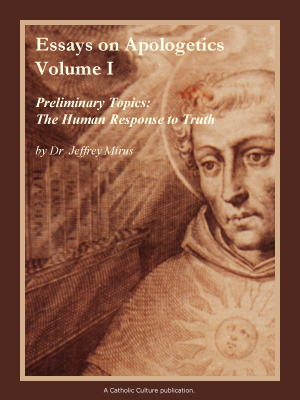Catholic Activity: St. John's Eve Bonfire
The Birth of St. John the Baptist falls around the summer solstice, and is known as the "summer Christmas." Picnics and bonfires on the eve of the feast are traditional, as Florence Berger explains. She also introduces some other customs from around the world for this feast day, including the hymn "Ut queant laxis."
DIRECTIONS
June 24 is one of the oldest of the Church feasts. It is the birthday celebration of St. John the Baptist, and is sometimes called "summer Christmas." On the eve of the feast, great bonfires were once lighted as a symbol of "the burning and brilliant" light, St. John, who pointed out Christ in this world of darkness. The solstice fires had been pagan, but now they were blessed by the Church in John's honor. There are actual blessings for the bonfire in the Roman liturgy. Magical and superstitious elements of food and drink were forgotten, and we were encouraged to have great picnic feasts out-of-doors around the blazing logs. The outdoor grill, so popular in our own back yards, was once less selfish and more communal. We feasted as many neighbors and not as exclusive individuals.
There are all sorts of special foods used on the feast day of St. John. Each country makes a contribution to the joy and festivity. There is no world-fellowship quite so genuine as the mystical body of Christ celebrating. The St. John's menu really is quite international. Wynkyn de Worde of old England cooked a wonderful soup for the occasion in the manner of his ancestors. In Mexico this is a day for bathing, singing, dancing and eating. Great hampers of chicken tamales and stuffed peppers are carried to the swimming parties. In Sweden salmon and new potatoes were the appropriate entree and strawberries were the dessert which was first choice. It was Latvia, however, which made a national holiday of this feast, and each man or boy with St. John's name was honored. Every house had open house, and the table was set with cold cuts served with grated wild horseradish, bread, butter, honey and sweet beer.
Sweet beer was a sort of home brew which always was drunk on the great Latvian festivals. Barley and rye were moistened and germinated. The germination was then checked by complete drying; the resulting malted grain was roasted in an oven while hot water and hops were added. The brew was placed in barrels and strained through layers of straw. You can see how much trouble people will go to in order to celebrate. Naturally we prefer to substitute American beer for Latvian home brew.
Singing groups in the northern countries would go from door to door much like Christmas carolers only on this day they sang:
"Ut queant laxis resonare fibris (Do-re) Mira gestorum famuli tuorum (Mi-fa) Solve poluti labei reatum (Sol-la) Sancte Johannes." (Si)"As thy servants sing with full voice the marvels of thy works, do thou purify their sinful lips Saint John." And as the hymn mounted the scale from Do to Si, the housewife of Latvia would rush to the door with her hands full of bread and cheese while her husband stood in the background holding a mug of beer with which to lure in the singers. There was also a special cheese called John Siers or Saint John cheese. I believe it was made of goats' milk like the brown cheese of Norway.
This idea of using bread and cheese as an attraction to entice guests into your house was employed as late at 1826 in Yorkshire, England. There, on St. John's eve, the newcomers in a parish placed small tables holding bread and cheese and beer outside their doors. (They probably served the famous Wensleydale cheese, best of all English cheese. Wensleydale cheese is a double cream cheese, like Stilton, which grows "blue" when ripe. It is made only from June to September.) Passersby were thus invited to eat at the stranger's door, and at the proper moment that door would open with a "come in" invitation. In this way, no new resident was a stranger for very long. There is much to be said for the custom because we have known how it is to live in a parish of strange names and faces. With all the moving days which we have here in America, we could use the bread and cheese lure for friendship several times a year in some families.
Last year in our home we celebrated St. John's Day in games and plays and dances in front of the bonfire. It was fun to tell stories of ghosts and witches — all of whom would keep respectful distances from St. John's light. Mary and Ann gathered St. John's herbs from field and garden, and I told how they had been used as medicines, charms or food. Most of the yellow flowers once belonging to the cult of Balder, the sun god, are now St. John's flowers. It is amazing to learn how many flowers are dedicated to this beloved saint.
When the flames had died down to glowing embers, we brought out the long-handled griddle and made sweet pancakes. You seldom think of pancakes at a grill, but they are excellent. The batter is easy to carry to a picnic in a Mason jar. The recipe we used was one from Finland where pancakes are the proper traditional supper on St. John's eve.
Served with ripe red raspberries, fresh from the garden, Finnish Pancakes are sure to make your bonfire party a success.
Activity Source: Cooking for Christ by Florence Berger, National Catholic Rural Life Conference, 4625 Beaver Avenue, Des Moines, IA 50310, 1949, 1999






